Fuzzy Case-Based Reasoning in Product Style Acquisition Incorporating Valence-Arousal-Based Emotional Cellular Model
Abstract
Emotional cellular (EC), proposed in our previous works, is a kind of semantic cell that contains kernel and shell and the kernel is formalized by a triple- L = <P, d, δ>, where P denotes a typical set of positive examples relative to word-L, d is a pseudodistance measure on emotional two-dimensional space: valence-arousal, and δ is a probability density function on positive real number field. The basic idea of EC model is to assume that the neighborhood radius of each semantic concept is uncertain, and this uncertainty will be measured by one-dimensional density function δ. In this paper, product form features were evaluated by using ECs and to establish the product style database, fuzzy case based reasoning (FCBR) model under a defined similarity measurement based on fuzzy nearest neighbors (FNN) incorporating EC was applied to extract product styles. A mathematical formalized inference system for product style was also proposed, and it also includes uncertainty measurement tool emotional cellular. A case study of style acquisition of mobile phones illustrated the effectiveness of the proposed methodology.
1. Introduction
Natural language (NL) is used to describe the real world while NL is full of fuzziness and ambiguity, humans will create a vague concept on each object by using NL, whereas researching on implicit emotion of product style, NL are often unable to adapt to the quantitative calculation and qualitative analysis. Customer′s emotional evaluation is hided in NL that needs to be extracted and decomposed into words and adjectives, but separating these terms under such a simple way cannot fully express the human′s visual perception of product. In previous studies, it implicated that human emotion can be measured by two-dimensional value, called valence and arousal, where valence denotes the degree of exciting and calm and arousal denotes the degree of positive and negative [1, 2], which made important progress on presentation of human’s emotion. Further research was appeared in medical fields, a large number of medical experiments indicated that two brain-specific chemosensory domains, amygdala and the orbital-frontal cortex, were linked to valence-arousal [3–5]. However, can different words and different degrees of emotional stimuli be corresponded to certainty domains of these two brain chemosensory signal characteristics? This is a very important basis related to the underlying data acquisition and the scientific foundation of product style description model. PA Lewis observed specific brain areas, including the orbital frontal cortex, anterior cingulate, insula, amygdala, brain stem, pons, and striatum, and other parts of the active peak by magnetic resonance imaging (MRI) technique under different emotions (affective words) and varying degrees of stimulation, it indicated that the orbital frontal cortex is highly correlated with arousal, and the amygdale was highly correlated with valence, this work founded a relationship between low-level physiological signals and high-level semantic concepts [6].
Emotional cellular (EC), introduced by our previous works, was developed based on Labe semantic (LS) and prototype theory (PT) [7, 8], the theoretical aspect LS is defined by set theory that demonstrated the semantic representation under final measure of the accuracy of the description, which is mainly based on logical and accurate measure of the quality function and its synthesizing manipulation. However, in practical examples, the distribution status of mass function was much more difficult to learn that required a priori knowledge and statistical methods. Although the LS theory was reasonable by using emotional vocabulary to generate expression which provided a theoretical basis for EC model under probability aspect, but in the semantic space, the LS theory needs to conduce a formal definition of the expression, and the ultimate goal is to obtain independent semantic concept that takes advantage of this concept of semantic content and to determine the fuzzy boundaries inherent in the product hidden emotional elements. PT established the conceptual model for semantic extraction through a neighborhood-based calculation method and also produced a rule-based reasoning model. The basic idea of PT is to extend the concept to certain but unknowable boundaries of a random set-Pi, which denotes a representation of the concept that belong to classic set. is a neighborhood of concept semantic. So that About Pi can describe the uncertainty of concepts. So, it is reasonable that emotional cellular based on valence-vrousal was used to extract implicit emotion of products, and also appears more stable performance especially for uncertainty and inexactly representation of product implicit emotion images [9]. In industrial design (ID) field, the stability appearance of implicit emotion is an important characteristic of the formation of products style, and the product style features always focus on the emotional evaluation on product forms; so, this paper will use the EC model to extract product style employing fuzzy case-based reasoning (FCBR) technologies.
case-based Reasoning (CBR) refers to use of existing experience under a suitable similarity definition to find a solution to the problem, or revise the past cases while making decisions on new case. The advantage of CBR is that system does not need to enter the entire cases in advance, but simply to rely on the reasoning process comparing with current problems and past cases that have more application on text inference and pattern recognition fields [10–12]. The basic idea of this paper is to map each emotional cellular of valence-arousal space into a “case” and the kernel of emotional cellular represents the central of case, that is, the typical value of case. The density function of emotional cellular was defined to the similarity between cases.
While in actual process, CBR method must be combined with fuzzy sets that will take more effective for feature extraction of product style due to the uncertainty on knowledge representation of the products style, form features, attributes description, and the definition of similarity measurement; so fuzzy case-based reasoning (FCBR) was introduced subsequently [13–17].
In the 1980s, Schank [18] and his students firstly introduced CBR further improved by Janet Kolodner′s and Michael Lebowitz′s who developed two software systems called CYRUS and IPP [19, 20]. Case retrieval is an important direction in CBR research while Hllermeier et al. [21] used generalization of the similarity measure to improve the efficiency of case retrieval, and fuzzy sets make it even more powerful for CBR. Wu et al. [22] analyzed the application of fuzzy set theory to CBR process of various issues and gave many solutions while other scholars committed to the integration of CBR in fuzzy clustering and fuzzy reasoning to improve the performance of the system.
CBR emphasizes the connection between cases and makes it more feasible for researching the formation of product style. In conceptual design (CD) fields, Cheng et al. [23] used 100 products to establish a FCBR reference model under a given similarity metric method in creative product design system. In summary, CBR is the process of solving new problems based on the solutions of similar past problems, it has its unique advantages on the field of ID; the EC model introduced in CBR will improve the ability of knowledge representation according to the manner of human thinking, and overcome the weakness that CBR’s original case presentation always falls into a single logical system and only suitable to clearly defined issues. In EC-based CBR inference process, knowledge base is established easier and more suitable to product style feature extraction [24–26].
2. Four Steps of Case-Based Reasoning
- (1)
Retrieve: retrieve cases from memory, that are, relevant to solving a target problem. A case consists of a problem that how the solution was derived.
- (2)
Reuse: the solution from the previous case was mapped to the target problem for that it need to involve adjust the previous solution to fit the new situation.
- (3)
Revise: test new solution, if necessary; revise it after having mapped the previous solution to the target situation.
- (4)
Retain: store the resulting experience as a new case in memory after the solution has been successfully adjusted to the target problem (Shown as Figure 1).
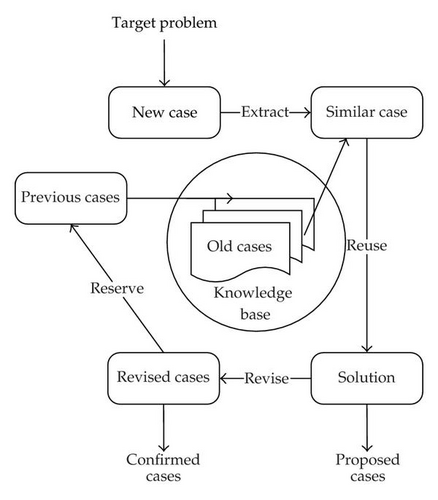
3. Similarity under Fuzzy Nearest Neighbor for Product Style Extraction
Fuzzy logic can deal with the expression of fuzzy language better, such as, “very good,” “good,” “bad,” and “very bad.” Combining with fuzzy sets to CBR process, a fuzzy preference function was defined to calculate the similarity between the corresponding properties for target problems. The result of fuzzy preference function is a vector, called the fuzzy preference vector (FPV) while the vector contains the fuzzy preference value for each attribute; extracting fuzzy preference function allows comparing some particular characteristic under completely different scales.
Nearest-neighbor (NN) technology was used to calculate the similarity between cases, comparing the relative properties for each new case and previous cases under given case weights, the total weight (weighted sum) was calculated and applied to sort the candidate cases. Most of the CBR systems use this method, and the degree of similarity may often be normalized into a number between 0 and 1, where 0 denotes completely different, 1 denotes exactly same, or as a percentage while 100% is representative of exactly same. This theory was first introduced by Fix and Hodge [31] and subsequently developed by Glass et al. [32] and Devijver and Kittler [33] and Wilson [34] that made some progress in data mining and image recognition. Kuncheva [35] and Liaw et al. [36] proposed a precise KNN algorithm using orthogonal search tree method to improve the accuracy of pattern recognition.
In the investigation stage, product style features need to be described more closely to natural language. In previous studies, the usual practice was to use linguistic variables (LV); LV is simplify of natural language and also combined fuzzy set theory. Table 1 shows the typical linguistic variable and its scale. However, the membership functions of LV is not linear, the specific value will come from the prior analysis by experts.
| Scale | 1 | 2 | 3 | 4 | 5 | 6 | 7 | 8 |
|---|---|---|---|---|---|---|---|---|
| Variables | 2 | 3 | 5 | 5 | 6 | 7 | 9 | 11 |
| None-N, N | Y | |||||||
| Very low, VL | Y | Y | Y | Y | Y | |||
| Low-very low, V-VL | Y | |||||||
| Low, L | Y | Y | Y | Y | Y | Y | Y | Y |
| Fairy low, FL | Y | Y | Y | Y | ||||
| Mol low, ML | Y | Y | ||||||
| Medium, M | Y | Y | Y | Y | Y | Y | ||
| Mol high, MH | Y | Y | ||||||
| Fairy high, FH | Y | Y | Y | |||||
| High, H | Y | Y | Y | Y | Y | Y | Y | Y |
| High-very high, H-VH | Y | |||||||
| Very high, VH | Y | Y | Y | Y | Y | |||
| Excellent, E | Y |
Fuzzy nearest neighbor (FNN), first proposed by Keller et al. [37] in 1985, is mainly to describe cases using fuzzy set, its advantage is that system can capture more cases whose fuzzy memberships are bigger than a given threshold, and provide support information for decision making to reduce the errors. A typical FNN algorithm is shown in Algorithm 1 and Figure 2.
-
Algorithm 1
-
Let C = {C1, C2, …, Ck} be the number of classifications
-
START
-
INPUT X = {F1, F2, …, Fl} // input cases
-
i = 1
-
DO UNTIL i > k
-
COMPUTE d(X, Ci) // calculate the distance between the input vectors and the first
-
class
-
COMPUTE m(X, Ci) // calculate the fuzzy membership of input vector belonging to a
-
class.
-
i = i + 1
-
END DO
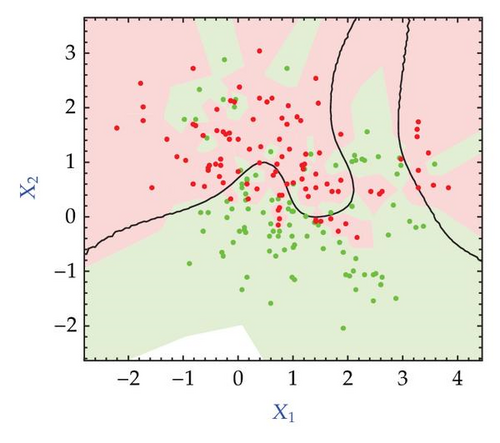
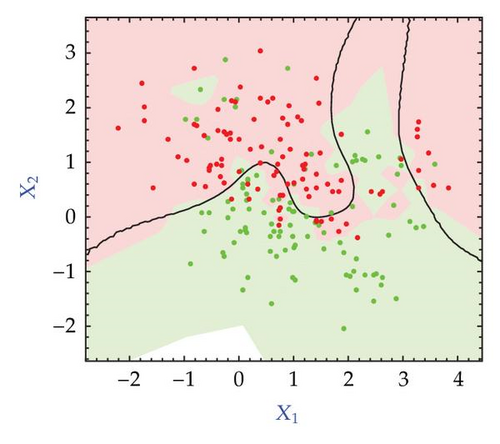
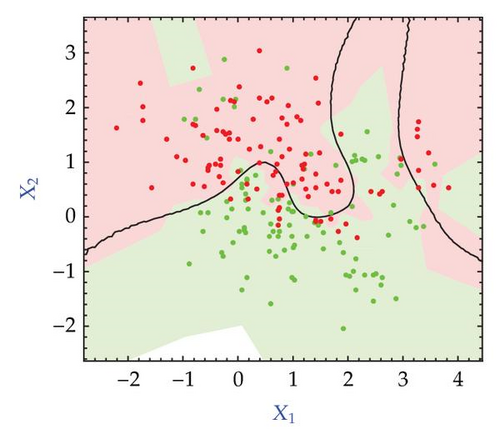
While properties of each case may represent different importance degrees, we must set each weight relative to a property in order to find the most similar case more effectively and accurately. For NN algorithm technology, the distribution of weights will help us to acquisition “good” case. However, value selection for weight of property is very difficult, traditionally, weights are defined by experts according to their expertise or experience in practice.
Combining with FNN and CBR by using discrete scale-LV cannot be more exact to describe product style, so the EC model needs to be used in this reasoning system. By the above discussion and analysis, the similarity formula for cases is also redefined.
4. Product Style Acquisition by FCBR Employing EC
4.1. Emotional Cellular Theory
4.1.1. Definitions on Kernel of Emotional Cellular
In a previous experimental study [1], we got the distribution of each point set for each emotional vocabulary in valence-arousal space. The analysis revealed that the distribution of different emotions vocabulary in valence-arousal space is not the same and can be divided into three categories: single point type (indicating that the emotional evaluation has a strong consistency), planar type (that poor consistency of the emotional evaluation), and circular type (for the emotional evaluation under a medium consistency). So the spatial distribution and its different topological forms of point set need to be redefined respectively. For this situation, The emotional cellular model is actually a very special semantics cell model that is defined on the domain of two-dimensional valence-arousal emotional space which contains two parts: semantics kernel and semantic shell. Semantic kernel is a typical values in valence-arousal space, it means that all cells belonging to the emotional element of a typical valence-arousal value; emotional shell covers the areas of emotional vocabulary boundary, it is uncertain in nature, which uses a density function to represent the distance uncertainty. The kernel is a classic set that takes many forms such as single-point set and a collection of circular; and its shell also is under a variety of forms of density function, such as single Gaussian model (SGM) and Gaussian mixed model (GMM). This paper will develop SGM and GMM in EC model based on Olvi Mangasarian and Wang’s works [38, 39]. Definitions were given as follows.
Definition 4.1. For ∀P ∈ Ω, P is a point that belongs to the universe Ω = {(E1, E2, …, En) : Ei ∈ P. Particularly, P = (valence, arousal) in valence-arousal emotional space: P = (v, a), Ω = {(v, a)∣v, a ∈ R}.
Definition 4.2. Distance d = ∥·∥ in valence-arousal emotional space, satisfied by the condition as follows:
Definition 4.3. for ∀P ∈ Ω, there is a neighborhood :
Definition 4.4. Single-point kernel is defined by
Definition 4.5. Circular kernel is defined by , where , K′ ⊂ Kand K′ = {Pi∣ρ(Pj) ≤ ρT}, ρT is a given const to limit the scale of kernel.
Definition 4.6. Flat kernel is defined by {⋃iPK}, where PK is subject to Definition 4.5.
4.1.2. Definitions on EC’s Shell
The shell of EC gives the scale of neighborhood of all emotional elements that is uncertainty called “soft membrane” which is defined by the following.
Definition 4.7. Upper approximation shell: , lower approximation Shell: , then shell of EC is PB = UPB∖LPB, which denoted by N(u, v), where u, v are related to the density function.
4.1.3. Probability Density of EC Employing Gaussian Model
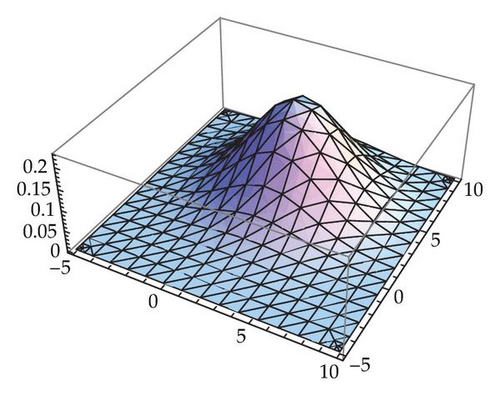
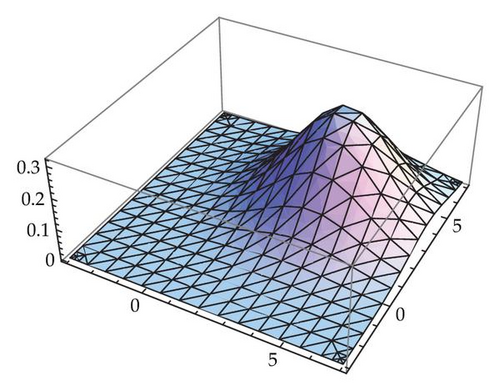
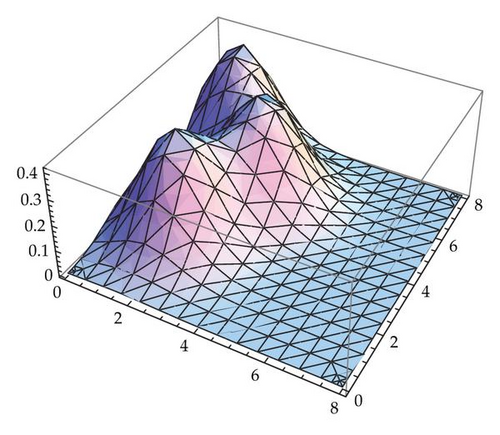
4.2. FCBR of Product Style
Firstly, we need to define the target problems, while using EC, we have the following.
Definition 4.8. Given a universe Ω = {Qi : i = 1,2, …, n}, it is a finite set, let Qi ∈ Ω be a case of case space which is formalized as a triple: Qi = (Pi, ρ(Pi), G(Pi)), where Pi is the kernel of EC, ρ(Pi) is the probability density function of Pi that is used to set the weight of cases, and G(Pi) is a EC which contains Pi as its kernel.
Definition 4.9. Given a product features space Φ = {Ci : i = 1,2, …, m}, for each product Ci = {Fi1, Fi2, …, Fik} ∈ Φ, it is a finite set, where Fi is form feature. Let Style(Ci) ⊂ Ci be style features subset of Ci that is the features relative to product style in Fi.
Definition 4.10. For any two style feature subset Style(CK) and , we defined that
-
(1) Style(¬CK) = Style(CK) c,
-
(2) .
Definition 4.11. Let be the extend set of Style(CK) Style(CK), which denotes the new style features set after revise.
Construct a mapping between product feature space and case space-based EC: Φ → Ω : {Style(Ci) ↦ Qi}, that is Qi = (Pi, ρ(Pi), G(Pi)) is applied to describe Style(Ci).
Definition 4.12. For case base C = {Ci : i = 1,2, …, k} and Ci = {Fi1, Fi2, …, Fik} ∈ Φ, mapping F → Q, we have that
Definition 4.13. The distance between form feature Fij and EC-Q is defined as Euclidian distance in valence-arousal space under Definition 4.2.
Definition 4.14. let Style(CK)≻Style1(CK)≻Style2(CK)⋯≻Style*(CK) be a strictly increasing nested set, Style*(CK) be a stable style feature set while studied from CBR process.
Definition 4.15 (FNN). Let case base C be involved of EC Q = G(P), the similarity between the new case Ci = {Fi1, Fi2, …, Fil} and previous case was defined by
Definition 4.16. Style features subset calculation under fuzzy expression for new case:
Definition 4.17. For new case Ci, if its fuzzy membership is less than a given threshold δ by Definition 4.16, then let C* = C ∪ Ci, while Style(C) * is the extend set of Style(C) that is Ci is retained.
The frame works of FCBR process was illustrated by Figure 5.
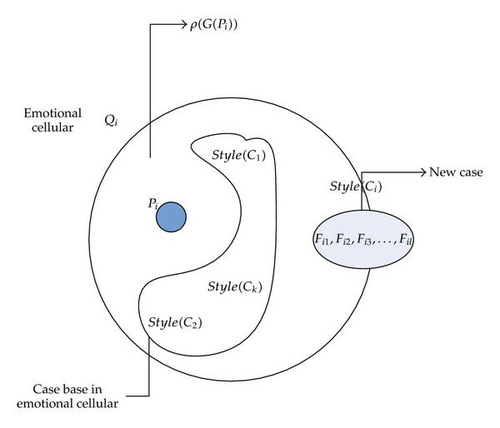
5. Case Study
5.1. Construction of Product Database
The mobile phone was classified under form, layout (geometric connection), color, and material. In form feature classification, there have been 8 subclassifications: let {A, B, C, D, E, F, H}= {overall body form, ratio of body’s length and width, body’s thickness, shape of the screen cover, bottom form, body’s edges line, proportion between screen and body, form of the number keys} listed in Table 2.
| Class | Form features |
|---|---|
| A | {A1. linear, A2. convex arc, A3. concave arc, A4. prominence waist} |
| B | {B1. 1 : 1~1.5, B2.1 : 1.5~2, B3. 1 : 2~2.5} |
| C | {C1. thinner, C2. thin, C3. thick, C4. thicker} |
| D | {D1. independent to function keys, D2. combination with function key, D3. partly overlap with function keys} |
| E | {E1. small R angle arc, E2. arcs, E3. arc-shaped} |
| F | {F1. straight, F2. Small arc, F3. big arc} |
| G | {G1. 1 : 1, G2. 1 : 1~2, G3. 1 : 2~3, G4. other (large screen)} |
| H | {H1. rectangular, H2. oval shaped, H3. round, H4. other geometric shape, H5. divided by the surface shape} |
In layout classification, there have been 6 sub-classifications, let (I, J, K, L, M, N) = {arrangement of the numeric keys, function keys layout, the fuselage edge treatment, the number of the basic components, the basic operation way, surface segmentation approach} which is listed in Table 3.
| Class | Form features |
|---|---|
| I | {I1. same forms arranged in neat rows, I2. same forms but changeable alignment, I3. form changeable but in neat rows, I4. form changeable and changeable alignment} |
| J | {J1. large function keys, J2. symmetric dispersion function keys} |
| K | {K1. near to 0, K2. small R angle, K3. middle R angle, K4. big R angle, K5. semirounded} |
| L | {L1. two, L2. three, L3. four, L4. five, L5. six and more} |
| M | {M1. flip, M2. slide, M3. straight, M4. rotation} |
| N | {N1. by cover, N2. by frame, N3. by screen} |
In color and materials classification, there have been four subclasses: let (O, P, Q, R) = {screen edge processing, the keyboard color, body color, body surface treatment}, Table 4 shows the specific subclass and their coding.
| Class | Form features |
|---|---|
| O | {O1. metal decorative box, O2. printed decorative box, O3. gradient, O4. groove carving, O5. none} |
| P | {P1. silver, P2. black, P3. other} |
| Q | {Q1. silver blue, Q2. silver rose, Q3. black, Q4. swamp ash, Q5. light blue, Q6. pink, Q7. milk white, Q8. silver, Q9. deep blue of venice, Q10. deep in paris gold, Q11. deep red rome} |
| R | {R1. painting, R2. bright side, R3. acrylic, R4. metal, R5. plastic + rubber (Silicon), R6. key-film (IMD), R7. other} |
In color evaluation, 2-dimensional scale was applied in system shown in Table 5.
| Words | A | B | C | D | E | F | |
|---|---|---|---|---|---|---|---|
| Fortunately | Active | Varied | Lucky | Interesting | Peaceful | ||
| 1 | Optimistic | ||||||
| 2 | Stimulation | Y | |||||
| 3 | Sexy | Y | |||||
| 4 | Intense | Y | |||||
| 5 | Aggression | Y | |||||
| 6 | Gorgeous | ||||||
| 7 | Lively | Y | |||||
| 8 | Elegant | Y | |||||
| 9 | Rich | Y | |||||
| 10 | Mature | ||||||
| 11 | Healing | Y | |||||
| 12 | Wisdom | ||||||
| 13 | Cool | ||||||
| 14 | Protection | ||||||
| 15 | Security | Y | |||||
| 16 | Loyalty | Y |
5.2. Case Construction and Reasoning
Let F = [A, B, C, D, E, F, G, H] be form matrix, the values are relative coding of each selection, for example, F = [1,3, 2,3, 3,3, 4,5] denotes [A1, B3, C2, D3, E3, F3, G4, H5], and let G = [I, J, K, l, M, N], C = [O, P, Q, R], under fuzzy similarity computing was under definitions in Section 4.2.
5.3. Result and Discussion
78 mobile phones were used to construct case base through online questionnaire system. First, these 78 Nokia mobile phones will be formalized as (F, G, C), and whether those cases’ features belong to product style or not depends on the result from FCBR under the proposed similarity definitions mentioned above; for the same case in questionnaire system, it can seem to be the revise operation. If the similarity between new case and average case is less than a given threshold, then this new case will be retained. Partly cases were reserved to reflect the product style, and the critical form features were listed in Table 6. For example, “classic nordic” E50, its encoding is [A1B3C1D2E1F1G3H1, I1J2K1L4M3N, 3O4P3Q4R4]. Evaluation by two-dimensional color system is “optimistic” and “Active.” By FCBR process, average case is [B3C1D2M3]; with the style characteristics of the mobile phone has a metal body panels, T-shaped key generally placed in the phone right way, navigation key with control rods, digital array key layout, color friendly and simple, calm, and so forth. The results indicated that all features listed in Table 6 belong to Nokia traditional style which meet the high-ended business application need in market position.
| Style | Product | EC characterize code | Color Evaluation |
|---|---|---|---|
| Classical | N93 | C3E2I1M1 | 6D |
| Aristocratic | 8800 | E3G1M2R4Q2 | 7D |
| Rock | N70 | A1B2M3 | 10E |
| Dynamic Black | N81 | B3E1G4Q3R6 | 12F |
| Adore | 7088 | A3E2G2K4Q7 | 9A |
| Metal | 6275 | E2I1M2Q8 | 12B |
| Classic Nordic | E50 | B3C1D2M3 | 1B |
| Bohemian | 7373 | G3Q6 | 3F |
| Luxury | 7500 | D2H5J2Q3 | 2F6A |
| Apple iPod | N73 | G1I3M2Q7 | 6A |
| Simple business | E51 | I3O3P2R7 | 3E |
| Modern fashion | 7900 | D2H4P2 | 3E |
| Sport Transformation | 5300 | H2M2 | 4B6D |
6. Discussing and Concluding Remarks
6.1. Comparing with Traditional Methods on Product Style Evaluation
Comparing with traditional methods, such as KANSEI engineering, it applied KANSEI adjectives on perceptual evaluation and also needed the appropriate degree of adverbs to indicate customers’ preference on every product characteristics, such as “very”and “extreme”. However, this scale has great randomness and cannot be directly used for calculation; further improvement is Likert scale that used psychology to reflect the preference. It used scores to distinguish emotional level such as 5-point scale and 7-point scale; scores also can distinguish the corresponding positive or responsible for the emotional level, but the scale method is far too simple. The use of semantic differential method still does not solve the complex emotional quantitative problem, and also cannot reflect the perception of ambiguity. In this respect, fuzzy set was considered to be an effective solution. In the fuzzy set theory, the user is represented as a composite perceptual general form of fuzzy sets, and with the logical calculation on fuzzy set, the user’s overall emotional evaluation on products’ implicit emotion would be extracted, the methodology combining genetic algorithm was adopted in our works on TV style research [40]. Therefore, the linear function on weights distribution seems that it cannot reflect the exact expression of human’s emotion on product style. So, EC will be more feasible to deal with this problem. It also illustrated the effectiveness on case study of this paper.
6.2. Conclusions and Further Research
- (1)
Similarity computing in the style of the weight of morphological characteristics’ calculation is too complex while depend on probability density function of EC that limit the size of the experiment, and the accuracy of this density function remains to be further studied.
- (2)
Besides the form, layout, color, and materials, there are other factors, such as the use of functional brand recognition product emotional experience will also influence the product style formation. Therefore, the extraction of knowledge of product style was improved and developed continuously.
In the next step, case base will be established in a large scale while similarity computing must be under more reasonable definitions, weight distribution program, and inference system also would be improved, that is to carry out the depth mining for product style.
Acknowledgments
This paper is funded by Natural Science Foundation of Zhejiang Province under Grant no. Y1110322 and National Natural Science Foundation under Grant no. 61070075.




